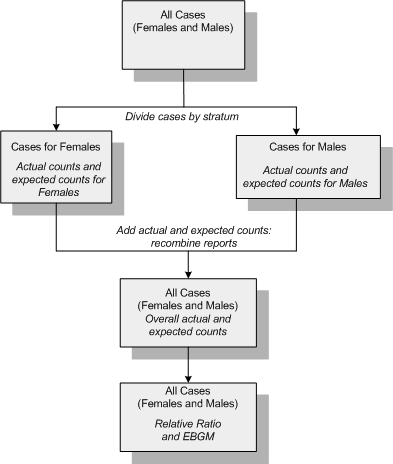
Item values can be associated in an MGPS data mining run because they are associated jointly with other variables, such as gender or age. To minimize the occurrences of this type of spurious association, use stratification variables in the results of an MGPS run.
For example, Drug X is generally prescribed for women above age 50 and Event Y also occurs more frequently for women above age 50. A data mining run indicates a strong association between Drug X and Event Y, based on the coincidence of the gender and age groups involved. To minimize the occurrence of this type of association, stratify the data mining run by Gender and Age Group. To do this, Gender and Age Group must be available as stratification variables in the configuration.
Stratification divides all cases into groups, based on one or more variables, for the computation of expected values (E). The Empirica Signal application sums these expected values across all of the strata to provide a single expected value for all of the cases in the background. This has the effect of adjusting the expected value (and the other statistics computed with E, including the Relative Reporting Ratio (RR) used in the MGPS computation) for the effects of such covariates as age, gender, and receipt year. In this way, you can perform data mining across the entire background set, yet still be protected from false results that can come from coincidental association with age, gender, and so on. With stratification, there is one set of results (as opposed to the multiple result sets generated by a subset variable).
Like item variables, stratification variables map to columns in the safety database. You cannot select the same variable as both an item variable and a stratification variable at the same time.
If you select stratification variables for your MGPS data mining run, and also choose to compute PRR (Proportional Reporting Ratios) and ROR (Reporting Odds Ratios), you can specify stratification to apply to those computations as well.
The following example shows how reports are divided and then recombined during data mining when you use the stratification variable Gender:
